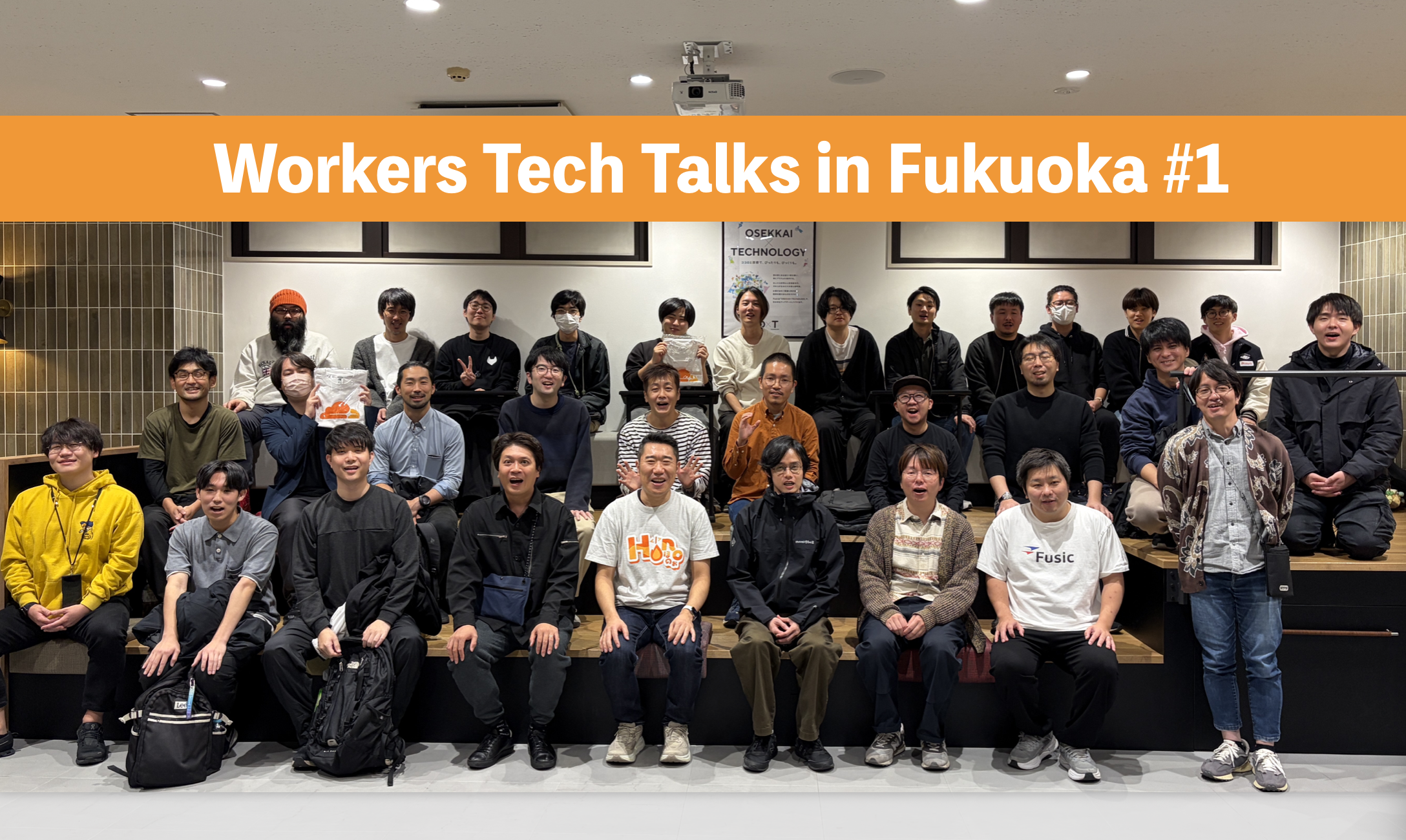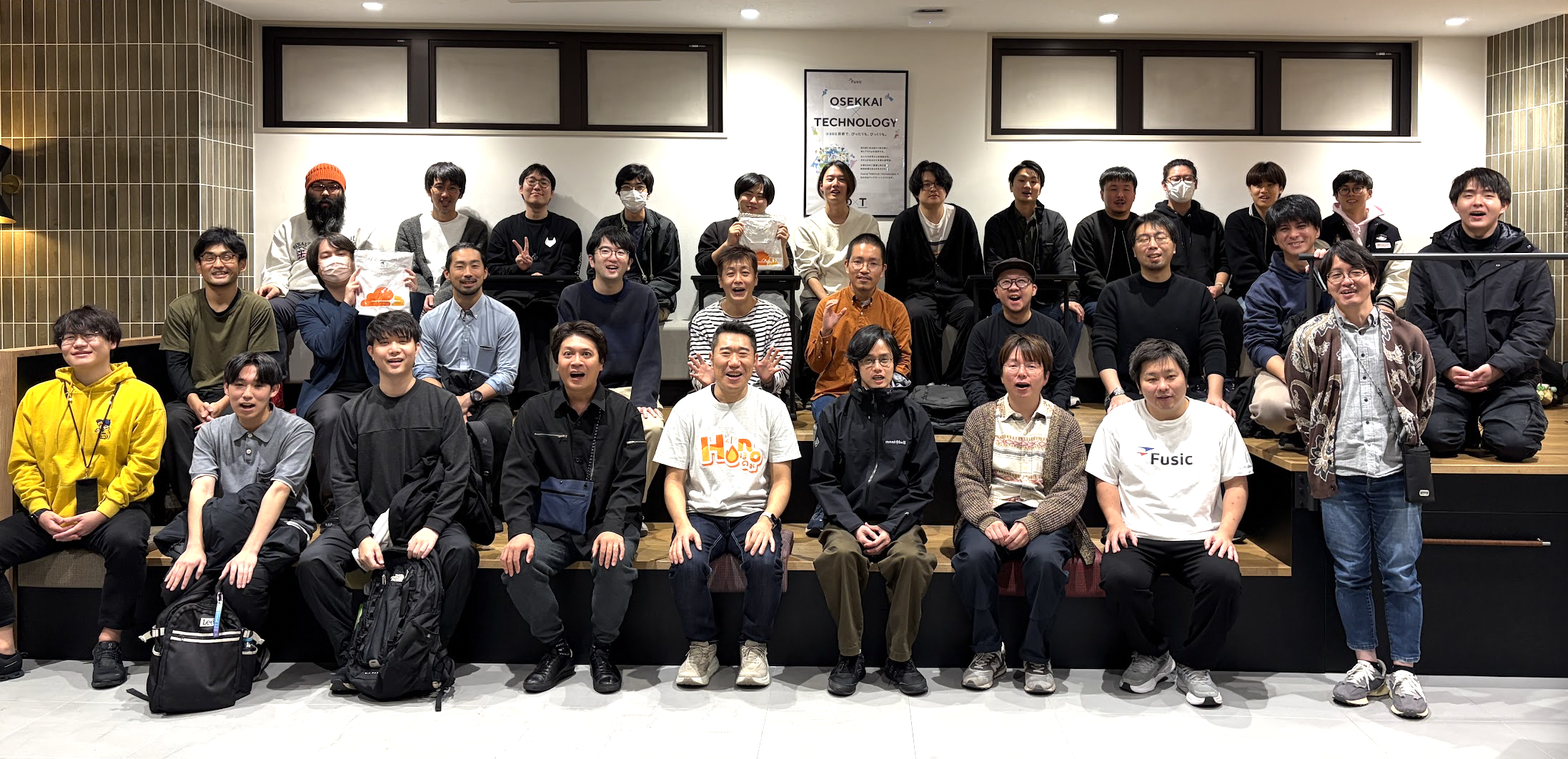
Cloudflare Workers Tech Talks in Fukuoka #1
Cloudflare Workers Tech Talks in Fukuoka #1
On November 12, 2025, we held Cloudflare Workers Tech Talks in Fukuoka #1 at Fusic’s open office in Tenjin, Fukuoka. This was the first Workers Tech Talks event in Fukuoka, bringing together Cloudflare Workers enthusiasts and developers from the Kyushu region.
What is Cloudflare Workers Tech Talks?
Cloudflare Workers Tech Talks is a series of tech meetups for developers passionate about Cloudflare Workers and its ecosystem. The format is simple: speakers share their use cases and implementation details without needing to explain “What is Cloudflare Workers?” This allows for deeper technical discussions and practical insights.
Previous events in the series:
- Cloudflare Workers Tech Talks in Tokyo #1
- Cloudflare Workers Tech Talks in Tokyo #2
- Cloudflare Workers Tech Talks in Osaka #1
- Cloudflare Workers Tech Talks in Niigata #1
- Cloudflare Workers Tech Talks in Tokyo #3
- Cloudflare Workers Tech Talks in Sapporo #1
- Cloudflare Workers Tech Talks in Tokyo #4
- Cloudflare Workers Tech Talks in Hokkaido #1
- Cloudflare Workers Tech Talks in Tokyo #5
- Cloudflare Workers Tech Talks in Tokyo #6
Venue
The event was hosted at Fusic’s open office, located in the heart of Fukuoka’s Tenjin district at 4-1-1 Tenjin, Chuo-ku, Fukuoka 1F. Fusic generously provided this modern and accessible venue, which was perfect for our technical talks and networking. We are very grateful to Fusic and especially to Seike-san for their support and hospitality in helping organize this event.

Attendees
The event registration was managed through Connpass, where we had 37 registrations with 40 spots available. On the day of the event, we had 32 attendees who joined us for the technical talks.

Talks
Deploying Full-Stack Bun Applications on Cloudflare

浦田大貴 (@daiki_uratan)
Daiki from Fusic introduced Guren, a Laravel-inspired full-stack framework that runs on Bun. He shared his experience deploying it to Cloudflare using Cloudflare Containers, including the challenges he encountered along the way. Interestingly, Guren’s logo appears to be inspired by Hono!
Slides: https://speakerdeck.com/7nohe/deploying-full-stack-bun-applications-on-cloudflare
Cloudflare Sandboxの仕組み

syumai (@__syumai)
syumai explored the Cloudflare Sandbox SDK, diving into both practical usage and internal implementation details. He demonstrated an MCP server that executes Go programs using the Sandbox SDK, successfully showing a live demo of calling it from the web version of Claude.
Slides: https://speakerdeck.com/syumai/try-cloudflare-sandbox
r2-image-worker
Yusuke Wada (@yusukebe)
I introduced r2-image-worker, a simple application for storing and serving images from R2. The project showcases the essence of Cloudflare’s platform by utilizing Secrets, R2, and Images. Features like Basic authentication and caching were easily implemented using Hono’s middleware. Attendees were impressed by the macOS Shortcuts integration that allows uploading screenshots directly to R2.
Slides: https://speakerdeck.com/yusukebe/r2-image-worker
Technology for Instantly Delivering Browser-Drawn Images

Kaido (@odiak_) from Efic
Kaido presented Kakeru, a browser-based notes and whiteboard application. He demonstrated the image sharing feature that allows users to share their drawings as images, implemented using Workers. An interesting aspect was the use of KV to cache the original image data for performance optimization. The live demo was particularly exciting, with multiple attendees simultaneously drawing on the same board in real-time, which impressed the audience.
Slides: https://docs.google.com/presentation/d/1JOTaGh-o45kM9vtRGnvJikz8NNX-cfHrqYTFOhU8iSM/edit?usp=sharing
Lightning Talks
We had two lightning talks:
Building an Authenticated Remote MCP Server with Cloudflare

ひめ (@hyme)
Hime shared his passion for ramen and built an MCP server for ramen shop reviews using Cloudflare Workers. He implemented access control using Cloudflare Access and the Cloudflare OAuth 2.1 Provider, which was an inspiring approach that caught my attention.
Slides: https://speakerdeck.com/nyawach/cloudflarederen-zheng-fu-kirimotomcpsabawotukurimasita
Why We Chose Hono for Acsim: Decision-Making in an AI Requirements Definition Platform

Tadashi Shigeoka (@codenote_net)
Tadashi shared the technical decision-making process behind choosing Hono for his project. A key factor was the ability to use @hono/zod-openapi to generate OpenAPI specifications directly from TypeScript code, making it easy to share with the frontend. He also introduced a response schema validator middleware that validates response values—an interesting solution to a common challenge. This was particularly intriguing as it addresses a problem we haven’t solved yet, and I’m definitely interested in adopting this approach.
Slides: https://speakerdeck.com/codenote/why-we-chose-hono-for-acsim
Feedback
You can find posts and feedback from attendees on X using the hashtag #workers_tech.
Networking
After the talks, we held a networking session at a nearby izakaya, where 20 people joined us to continue discussions and connect with fellow developers in a more relaxed atmosphere.
Summary
Cloudflare Workers Tech Talks in Fukuoka #1 was a great success, bringing together the Workers community in Kyushu for the first time. Thank you to Fusic for hosting us, all the speakers for sharing their knowledge, and everyone who attended.
We look forward to organizing more events in Fukuoka and continuing to grow the Workers community in the region!
